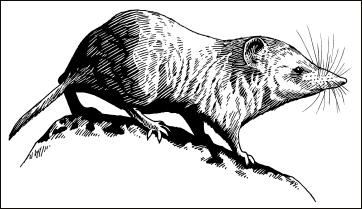

Ah, green forests and meadows and cool waters of the northland and the high country! Who would abandon that idyllic home for the raw desert—that land of dirt and rock, of barren mountains and searing sun, that land of never-enough-water. On the other hand, considering mosquitos, howling blizzards, bone-cracking cold, and never enough sun, one can think of reasons to leave.
Many over the years have traded the dubious joys of the land of
gurgling waters for the special gifts of the desert. Although most shrews, for example,
wouldn't be caught dead away from their verdant homeland, the Desert Shrew vacated
its ancestors' northern home eons ago to become, in the common vernacular, a desert
rat. However, that nickname is inappropriate for this miniature insect eater, who looks
vaguely like a long-nosed mouse. It actually belongs to an entirely different group and
is the only member of the family Soricidae to find its place in the sunny lowlands of
the Chihuahuan Desert.

Listen to the Audio (mp3 format) as recorded by KTEP, Public Radio for the Southwest.
Contributor: Arthur H. Harris, Laboratory for Environmental Biology, University of Texas at El Paso.
Desert Diary is a joint production of the Centennial Museum and KTEP National Public Radio at the University of Texas at El Paso.

Drawing of Desert Shrew, © 1999 by Zackery Zdinak. Used with permission.

Desert Shrew (Notiosorex crawfordi); specimen from the collections of the Laboratory for Environmental Biology.
Armstrong, D. M. Desert Shrew / Notiosorex crawfordi. Pp. 54-55, in The Smithsonian Book of North American Mammals (D. E. Wilson and S. Ruff, eds.). Smithsonian Institution Press, Washington, D.C., 750 pp.
The Shrew Photo Gallery.